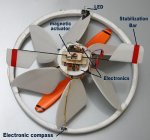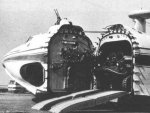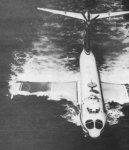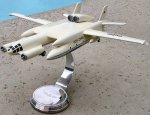LGoodhind
Member
- Joined
- Dec 1, 2003
- Messages
- 662
- Location
- Redmond, WA
- Aircraft
- former builder- project in mothballs
- Total Flight Time
- 12
>This implies that having two coaxial actuator disks directing their efflux at each other can represent ground effect and thereby improve the efficiency of both disks.
are you saying...
___v___+____v____ (clockwise)
___^___+____^___ (anti-clockwise- artificial ground effect)
...with the arrows representing the flow direction? If so you're pushing yourself up by your own bootstraps- conservation of energy .. the lower rotor is throwing mass up so the reaction is down thrust.
How about this...
___v___+____v____ (clockwise)
Where F is fuel and E is an engine of sufficient horse power (http://www.recpower.com/f33.htm) ... Rotor 2 can/will rotate at some speed in relationship to rotor 1 with the net effect being to cancel the torque of rotor 1. Fixed blade incidence and diameter the rotors would be chosen to maximize thrust in the normal flight range. By increasing the velocity of the same mass of inflow air to the sum of the interacting rotors the thrust developed by a coaxial rotor is increased. This ignores the actual interaction of two airscrews in close proximity- there was a gyro that had a pair of counter-rotating props and the results in terms of noise, thrust, weight, and complexity.
The only control input through the rotorhead is throttle but if you wanted to know how the engine was doing, what the fuel level was, etc you would need to pass a info throgh a rotating U-joint. No idea if coaxial rotors or other exotics behave well when it comes to autorotation so what happens if your engine fails?
While you could use cyclic pitch feathering or Kaman servo tabs on the lower rotor to control rotor thrust that probably isn't required; without engine torque applied to the airframe you could apply cyclic by tilting the hub which wouldn't require a complex swashplate.
Of course if it's all that great you gotta wonder why everybody isn't flying a Bendix ... http://www.goantiques.com/detail,bendix-helicopter-1946,337513.html ... at least the stock isn't worthless; just need to hold on to it long enough.
are you saying...
___v___+____v____ (clockwise)
___^___+____^___ (anti-clockwise- artificial ground effect)
...with the arrows representing the flow direction? If so you're pushing yourself up by your own bootstraps- conservation of energy .. the lower rotor is throwing mass up so the reaction is down thrust.
How about this...
___v___+____v____ (clockwise)
(F)(E)
__v___+___v__ (anti-clockwise- rotor 2)Where F is fuel and E is an engine of sufficient horse power (http://www.recpower.com/f33.htm) ... Rotor 2 can/will rotate at some speed in relationship to rotor 1 with the net effect being to cancel the torque of rotor 1. Fixed blade incidence and diameter the rotors would be chosen to maximize thrust in the normal flight range. By increasing the velocity of the same mass of inflow air to the sum of the interacting rotors the thrust developed by a coaxial rotor is increased. This ignores the actual interaction of two airscrews in close proximity- there was a gyro that had a pair of counter-rotating props and the results in terms of noise, thrust, weight, and complexity.
The only control input through the rotorhead is throttle but if you wanted to know how the engine was doing, what the fuel level was, etc you would need to pass a info throgh a rotating U-joint. No idea if coaxial rotors or other exotics behave well when it comes to autorotation so what happens if your engine fails?
While you could use cyclic pitch feathering or Kaman servo tabs on the lower rotor to control rotor thrust that probably isn't required; without engine torque applied to the airframe you could apply cyclic by tilting the hub which wouldn't require a complex swashplate.
Of course if it's all that great you gotta wonder why everybody isn't flying a Bendix ... http://www.goantiques.com/detail,bendix-helicopter-1946,337513.html ... at least the stock isn't worthless; just need to hold on to it long enough.











